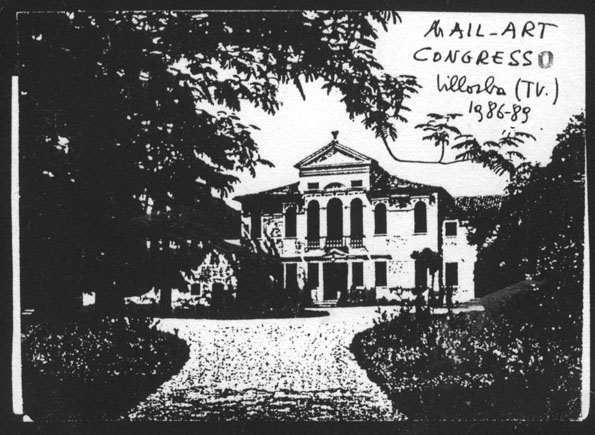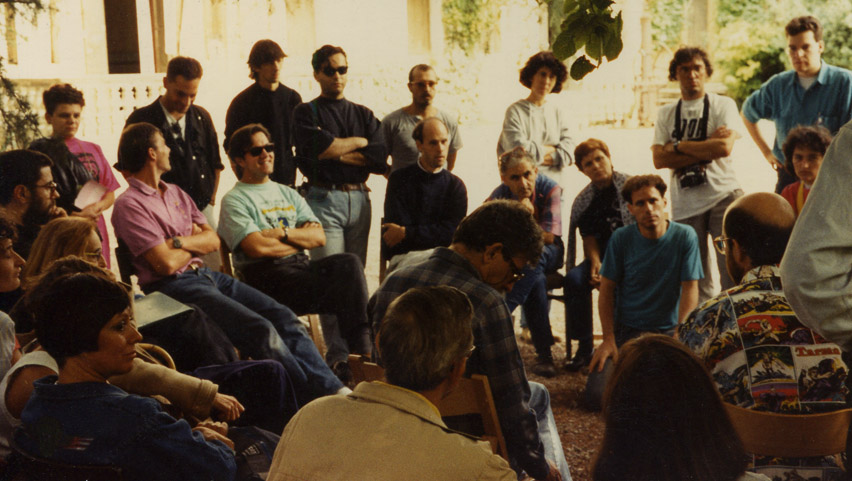 Beyond Mail Art to Cyberspace
Beyond Mail Art to Cyberspaceby Mark Bloch
If you take a look at the last recommendation drafted at the Italian Mail Art Conference in at Villa Fanna, below, you will see that as long ago as 1989 I proposed that mail artists reach out beyond art, beyond the realm of the mail art network to other disciplines.
That was immediately followed by my involvement with The Well and then Echo (www.echonyc.com) a teleconferencing BBS in New York City where I did less mail art and was instead engaged from 1989 to 1995 with a community of people of diverse backgrounds. There, my participation via computer teleconferencing, phone lines, modems and computers, as well as f2f (face-to-face) with writers, musicians, scientists, programmers, businesspeople, publishers, book editors, authors, filmmakers, carpenters, students, and mothers proved to be most valuable and a very satisfying fulfillment of my desire to reach others outside of the mail art circles.
I invited all networkers to log onto Panscan, a section of the Echo virtual environment, to join the dialogue with us. However, most mail artists did not have modems in those days. Nevertheless I proposed that unless mail artists know where they stand on a myriad of issues that are unique to us, they should be hesitant to attempt to exert their influence on people of other disciplines. A list of questions,  taken from some of my essays of that time, comprised my proposal for the 1992 Congress. Until these questions were answered, I proposed a 1992 Nongress, in solidarity with the International Word Strike that began January 1, 1991 and continued until December 31, 1993. I proposed that in an attempt to simplify and clarify what it is we were doing, networkers answer the questions and then get to work creating a network outside of traditional mail art waves.
taken from some of my essays of that time, comprised my proposal for the 1992 Congress. Until these questions were answered, I proposed a 1992 Nongress, in solidarity with the International Word Strike that began January 1, 1991 and continued until December 31, 1993. I proposed that in an attempt to simplify and clarify what it is we were doing, networkers answer the questions and then get to work creating a network outside of traditional mail art waves.
As you can see from the document drafted at the 1989 Italian Mail Art Congress the final recommendation, number eight out of eight, proposed by me and supported my others, advocated this point of reaching out to people in other disciplines. When I did this on Echo it proved invaluable. I taught them about mail art and they taught me about a great many other things. Many of them had gone through the Interactive Telecommunication Program ITP Program at New York University and that was the foundation of this comnmunity, though it quickly explanded to include all sorts of other non-ITP people, including me. At first I was the only artist but soonafter the system grew to include the first online experiences of the Whitney Museum, Paper Magazine, The Village Voice and other influential opinion makers in New York. Echo got quite a bit of buzz in the local and national press in those days of early cyberspace and the creation of "Silicon Alley" downtown. I was right in the middle of it, promoting the concepts that we used in mail art, networking, tourism, self-historification, the New York Correspondence School, Neoism, The Art Strike and others. Every one of those intelligent, influential people participated in Panscan the mail art networking tool I invented that soon grew far beyond mail art itself. It took the free-form, experimental mail art attitiude but became more about life in general with an art twist to it. The founder of the Echo system called Panscan a "performance in progress."
I always felt that the entire concept sprang forth from my sitting on the grass at Villa Fanna in Villorba Italian with the likes of our host Mariapia Fanna Roncoroni, Ruggero Maggi, Vittore Baroni, Piermario Ciani, Giovani and Renata Strada, Siglinde Karlbach, Achim Weigelt and other mail artists discussing mail art. (Click the pictures to enlarge.)